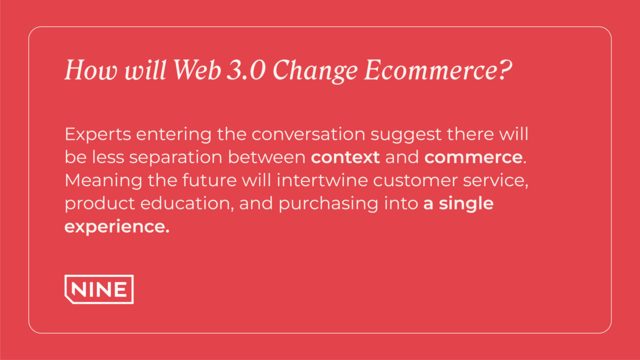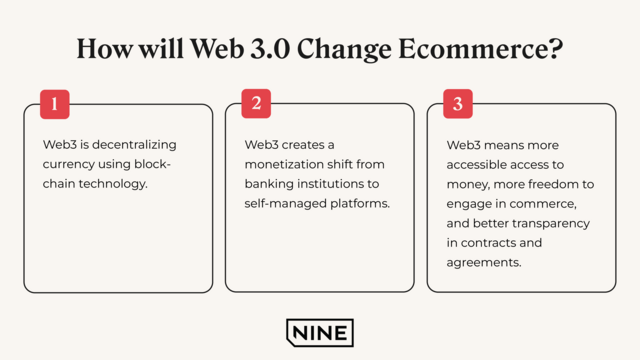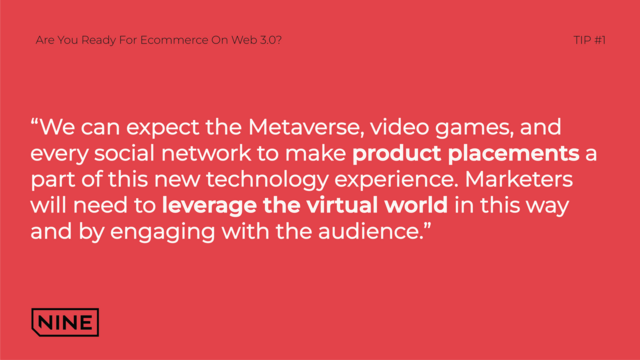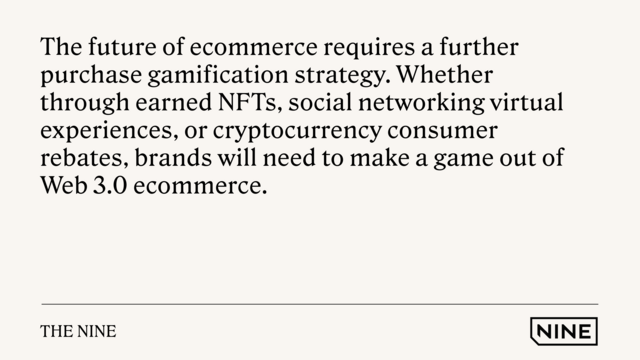
The possibilities of ecommerce on web 3.0 are endless. The possibilities should excite ecommerce Website owners as there will be more opportunities than ever to capture retail market share, but hear this warning. We should consider prioritization, budget, and competition before entering Web 3.0 ecommerce.
This article serves to explain how ecommerce will work on Web 3.0. While the future is unknown, there are ways you can leverage these technologies now for your online store. We will also forecast different strategies based on where we see Web 3.0 going.
Ready to immerse yourself into the world of Web 3.0? Put on your VR glasses, and let’s get started.
How will Web 3.0 Change Ecommerce?
Experts entering the conversation suggest there will be less separation between context and commerce. Meaning the future will intertwine customer service, product education, and purchasing into a single experience. Great news for keeping consumer attention but bad news if your marketing specialty is pattern interruption.

There will also be more intermingling between real-world and virtual experiences. It’s easy to assume that we will become an ecommerce first world. Still, there will always be a magnetic pullback to the physical world. So ecommerce brands will need to tie together the digital and physical experience of their products.
As we grow into Web 3.0, the presence and purchasing of digital assets will increase. All ecommerce brands will, at some point, benefit from producing products with digital asset ownership.
How Will Web3 Change Ecommerce?
One way where ecommerce will adapt to Web 3.0 is with Web3 digital currencies. Coined by Gavin Wood, the founder of blockchain infrastructure, Web3 is decentralizing currency using blockchain technology. Web3 creates a monetization shift from banking institutions to self-managed platforms.
If this sounds confusing, we understand. Web3 means more accessible access to money, more freedom to engage in commerce, and better transparency in contracts and agreements.
Web3 will be the primary means of currency transfer in the Metaverse. Ecommerce companies who want to be a part of this virtual world and prepare for complete Web3 integration. Otherwise, you will miss an ample opportunity where consumers are looking to build a new world full of digital experiences.

Omnichannel Retail On Web 3.0
To reiterate, Web 3.0 will not be the death of retail, nor will not be the death of traditional ecommerce. Omnichannel retail will be central to the success of any ecommerce company.
Let’s say you’ve developed a new line of vitamin gummies for kids. In Web 2.0, you might have created an ecommerce social media campaign with momfluencers talking about the benefits and how easy it is to take the product. Through ecommerce influencer marketing, they would make the pitch and push their audience to a website or Amazon store.
Influencer marketing still works, but further into Web 3.0, a richer experience will win out. The momfluencer will push parents into a virtual world where they can see, touch, and experience the product. Then, after careful label review, in a simulated way, they will press the try-now button, and the brand delivers a sample pack for the cost of shipping and handling.
The buyer journey story continues into the kids choosing their favorite flavor. Once the child picks their flavor, the parents purchase the flavor. As a thank you, the parents get VIP access to a “healthier kids” virtual experience where they can connect with other parents by making healthy decisions for their kids.
Does this sound far-fetched? It might seem that way, but brands like Onnit Nutrition will adapt to this business model. They currently sell their physical in places like Whole Foods and Walmart, but their website also offers certification courses and online events.
The Challenge of Ecommerce in Web 3.0
Brands that won on Web 2.0 were intentional about how they would implement the new social world into their marketing plan. We would see a brand rise through a single platform and stabilize as they increased messaging reach through the other platforms. On Web 3.0, the challenge will be the same; which technology do I begin with that gives me enough traction, so the others are easier to execute?
Brands that poorly execute on Web 3.0 will lose ground to brands that do it right. It creates the question; is this the right time for my ecommerce store to enter this unfamiliar landscape? Like a staging site for testing website changes, there is a strong case for testing web 3.0 technology on a smaller site with a smaller customer base.
Technologies Leading Web 3.0
From these technologies comes innovation at every turn. Consumers can use these categories to create conversations with their teams about implementing and innovating for marketing and operational purposes.
Artificial Intelligence
AI is the most used of the new technologies as a buzzword. We use AI to define simple improvements, but really, artificial intelligence speaks to more significant changes in machine learning. For ecommerce companies, AI means better reporting and optimizing business and marketing strategies.
Augmented Reality
Of all the wild things Web 3.0 will bring, augmented reality is the most practical improvement to our daily lives. AR will significantly improve customer service and product experience, but there’s another benefit in marketing. Through social proof, augmented reality will turn more social media followers into purchasers.
Virtual Reality
Gamers a ready to embrace VR for all it’s worth. Backpackers and outdoor enthusiasts, not so much. Having a headset is a polarizing topic, but VR benefits purchasing decisions. VR closes the gap between product interest and meeting product expectations. Through a virtual experience, customers can try your products before they buy them. This technology improves customer satisfaction and reduces your return rates.Digital Currency
You’re already behind if you’re not integrating blockchain technology and accepting digital payment methods such as cryptocurrency. The younger generation will growingly place their funds in decentralized platforms, and online retailers can take advantage of it now.
Non-Fungible Tokens (NFT)
As you know, there are already fully built-out ecommerce sites that only sell NFTs. Online shopping for premium digital assets will. In addition, we will see greater ownership of smaller digital assets. Where NFT ecommerce is essentially sitting separate from traditional ecommerce, we expect the future to merge these two forms of commerce.

What Customers Are Looking For On Web 3.0
Web 3.0 is young, and in the toddler years, there is a lot of trial and error. Brands can mirror this by exploring different aspects of web 3.0 and, with complete transparency, engage with customers during this trial period. An ecommerce brand might say, “hey everyone, let’s give this VR conferencing a try. No charge, show up and let’s see if it works.” Consumers receive this initiative and see it as a brand playing on the same playground.
Ecommerce Marketing On Web 3.0
The shift into streaming media forced movie and show producers to incorporate product placement as a revenue stream begrudgingly. Product placement became necessary to offset the lower total income from theater tickets, DVD purchases, and commercial ads. While these media companies were slow to adapt, virtual worlds will not.
We can expect the Metaverse, video games, and every social network to make product placements a part of this new technology experience. Marketers will need to leverage the virtual world in this way and by engaging with the audience.

Gamifying The Purchase
At its core, reward points are a primal way to gamify a purchase. They stimulate a dopamine release that encourages consumers “keep playing” until they achieve their desired outcome, AKA a discount. The future of ecommerce requires a further purchase gamification strategy. Even small businesses must consider including a gaming experience on the buyer’s journey.

Just as great marketing with mediocre products outperforms great ones with mediocre marketing, the purchasing differentiator in the new digital marketing landscape may be the gaming experience. Whether through earned NFTs, social networking virtual experiences, or cryptocurrency consumer rebates, brands will need to make a game out of web 3.0 ecommerce.
An Ecommerce Agency That’s Ready For Web 3.0
Are you an ecommerce brand looking for a strategic partner to help you navigate the changes in technology? The Nine is a digital ecommerce agency committed to helping our clients win in this new world. Through website development, social media marketing, and search engine optimization, we can help you drive more website traffic, improve the user experience, and generate more sales for your business.
Reach out to our fantastic team and learn how we can help your ecommerce site experience a digital transformation.

